Trophy hunting and cutting off horns: The new path for saving animals
By Lee Tulloch
The young black male rhino comes charging out of the bush, driven into the open by the helicopter hovering overhead.
From his seat in the helicopter, vet Dr Mike Scott fires a dart that precisely hits the rhino in the rump. The animal runs around for a minute or so, herded by the chopper, and then drops, the carefully calibrated tranquiliser taking effect. He’ll be down for 45 minutes.
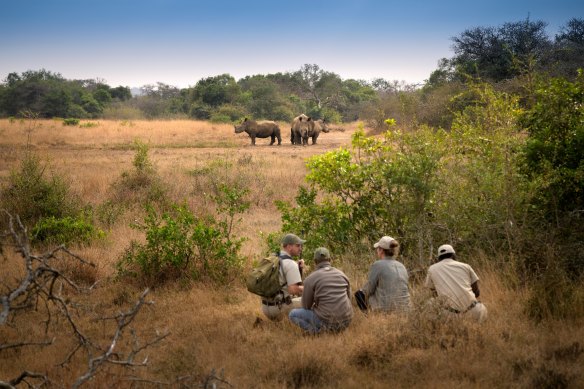
Saving rhinos – part of the campaign to save Africa’s wild things.
A team of handlers pounce and manoeuvre the two-year-old rhino so that he lies on his side. He’s kept cool with buckets of water, blindfolded and his ears are plugged. His breathing is monitored.
What happens next is shocking and emotional for those of us who love animals, even these less-than-cuddly, feisty, horned mammals.
Dr Scott picks up a chainsaw and noisily but quickly shears off the rhino’s horn.
It’s brutal, but the rhino feels nothing.
Rhino horns, popular for centuries in Asia as an aphrodisiac, are worth an astounding $450,000 each on the black market. Poaching is rife, well-organised, and difficult to stop due to endemic corruption in many African nations.
South Africa’s Kruger National Park has lost about 7000 rhinos to poaching in recent years – poachers kill the animal, making it easier to take the horn.
Joss Kent, chief executive of &Beyond, which owns and operates Phinda Private Game Reserve in South Africa, is one of the people convinced that removing the horns, and therefore taking away the attraction of the animal to poachers, is the best way to save the animals from extinction.
On this early morning, Kent stands in the long grass watching the de-horning, accompanied by me and several other guests from Phinda Forest Lodge, one of &Beyond’s six lodges on the reserve.
The program, which began in 2016, is hugely expensive given the manpower involved and the costs of helicopters, veterinary services and equipment such as tracking devices. Phinda has between 20 and 30 black rhino and 200 to 300 white rhino, and horns grow back every 18 months to two years. Dr Scott says he has removed at least 2000 horns.
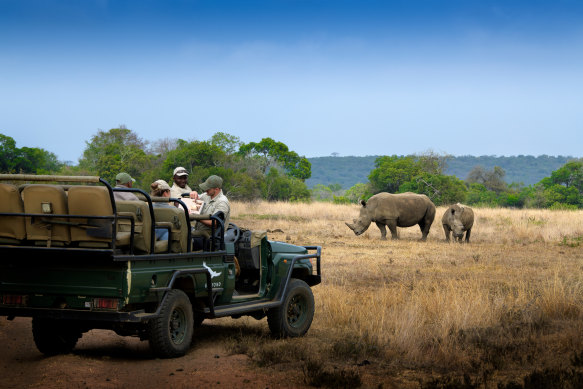
Rhino-spotting on safari in Phinda Private Game Reserve.
Joss Kent says he could sell the horns to fund the conservation, but he chooses not to, as he doesn’t want to encourage the “whole cycle of desirability of the horns”. But the program has been successful by every measure. Eight years down the track, there has been a 96 per cent reduction in poached animals. Phinda regularly sends rhinos to other reserves to boost populations.
Guests pay a fee for the activity (about $US3000/$4500 a carload) which directly supports the conservation.
We don’t stand around. While the animal is sedated, we measure its horn, help with microchipping and tagging his ears and assist when a tracking device is glued to the stump where the horn was taken. The horn is made of keratin, so we’re assured the procedure is like having his toenails cut.
We get to stroke him as well, patting the strangely soft, smooth skin that looks so rough. The black rhino is rare, and this is an incredible privilege.
He’s given an identification number, and we move away as BRM183 is slowly woken up with a reverse injection. He’s a bit wobbly at first, but then charges back into the trees, where his mother is waiting.
Later in the day, in another part of the reserve, we come across a female white rhino who has just given birth to a calf. The baby is still attached by umbilical cord. The mother looks wary but not alarmed. It’s as if she knows we are not there to do harm.
Protecting nature for people
Phinda Private Game Reserve occupies 29,866 hectares and seven diverse ecosystems in KwaZulu Natal, South Africa, south of Kruger and close to the Mozambique border. Forest Lodge within the reserve is set on 1000 hectares of Africa’s rare remaining dry sand forest. It’s only about 25 kilometres from the Indian Ocean and once was completely submerged by sea.
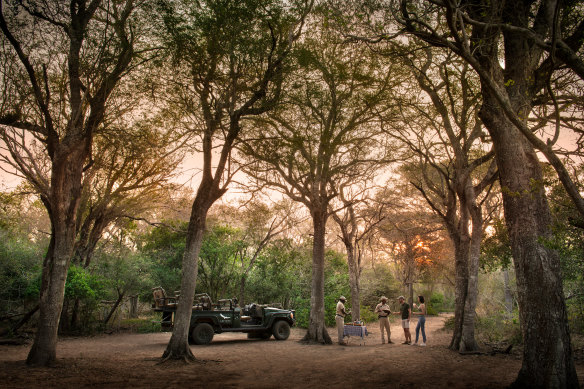
In the forest.
The eco-lodge is set on sand paths in a quiet forest of indigenous plants such as Lembombo wattle, False Tamboti and tiny pinhead orchids, under a canopy of enormous, ancient Torchwood trees. The forest is alive with other animals, such as hyena, bushbabies, owls and monkeys. There are canaries, robins and sunbirds flitting in the bushes.
The lodge’s guest area faces a grassy plain where elephants and leopards sometimes roam. Animals also wander through the forest at night, which is why guests need a guard to accompany them if they go out in the dark. There’s a handy pocket alarm, mostly for hyenas, if I need it. I don’t.
In my suite, which is a zen-like glass house wrapped in a wide verandah, I feel very much the intruder here. Families of gentle impala and petite suni antelope wander through the grounds and, curious, they sometimes come up to the window and stare at me as I tap on my computer.
Without tourism, it’s unlikely the expensive and decades-long conservation efforts of &Beyond and similar enterprises in Africa could exist. We tourists are needed, and I’m interested to know how and why. So, I’ve gone back to school.
I’ve travelled to Phinda to take part in a Wild Economy Masterclass, held by the company, in conjunction with the African Leadership University (ALU – alueducation.com), an innovative educational institution based in Rwanda which aims to raise a new generation of ethical leaders in Africa.
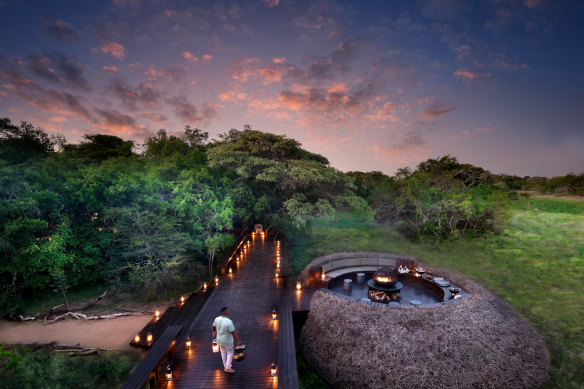
Phinda Forest Lodge.
Director of research, Dr Susan Snyman, founder Fred Swaniker and Ami and Dennis, current students at the university, join Dr Andrew Venter the chief executive of Africa Foundation and other invited guests for five days of intense conversation.
We will sit around campfires at dusk, dine in the forest at night, observe wild animals on safari and visit local Zulu villages to discuss ways wildlife and ecosystems – including animals, sea life, plants and people – can be conserved and protected by realising their economic potential.
“If we don’t change the narrative about conservation, very soon we will have nothing left,” says Dr Snyman.
“Until now it’s been about prohibition, restriction and protection. It’s been about keeping people away from nature. The conversation should be about protecting plants and nature for people, not against people.”
Josh Kent says that international travellers are growing increasingly more concerned about sustainable travel, and the time is right, he believes, to explore how wildlife can contribute as much as other resources like oil and gas to Africa’s economy.
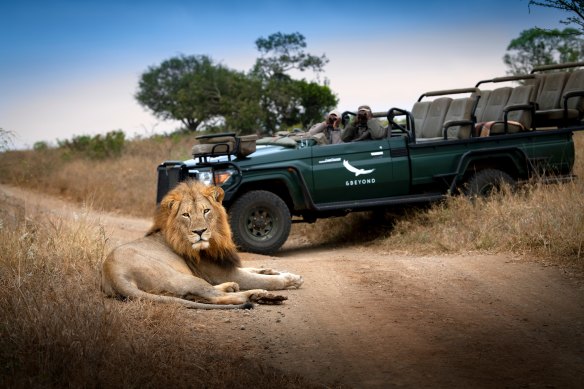
Roadblock.
“By seeing nature as an asset not just a resource … we can develop it, invest in it and grow it,” says Dr Snyman.
That includes ideas around sustainable hunting and ranching, eco-tourism, carbon trading, photo tourism, creating a market for forest products and medicinal plants, and promoting thriving communities by supporting a “hustle economy” of sustainability-minded small businesses such as bakeries, organic vegetable gardens and free-range egg suppliers.
A balancing act
Forest Lodge is ringed by two electric fences. The outer one is security for the reserve, the inner one is to protect the lodge from large animals, such as elephants – especially elephants.
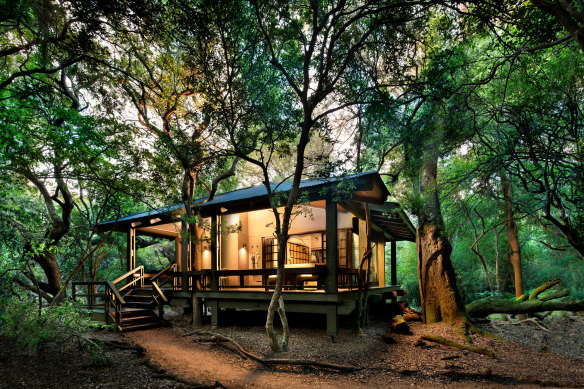
A guest suite at Phinda Forest Lodge.
Just beyond the inner fence, the ground is a graveyard of Torchwood trees, which the elephants tear out of the soil with their trunks. This is no small feat, as many of the trees, which grow only a millimetre a year and reach way into the sky, are more than 1000 years old. The enormous, swaggering elephants don’t sleep and often spend the night tearing up the forest.
On my first safari drive, a large herd of elephants cross in front and behind our two cars. We sit patiently until they move through the bush. Most seem unconcerned, but one huge bull elephant tearing branches off trees has his eyes on us. I’m feeling a bit uncomfortable, but guide Thul Ani says we’re fine if we don’t get too close or block his passage. Having seen the Torchwood trees, I can only imagine what might happen if the bull gets really irritated.
The animals in the reserve have a symbiotic relationship with humans. One night, after sundowners by a tranquil waterhole, we pile into the cars to head back to the lodge. Only then do we notice a large leopard, which has been sitting near us in the dark as we talk. He rubs himself in some dung to conceal his scent for hunting and then lopes beside us on the track for 20 minutes, until he peels off after his prey.
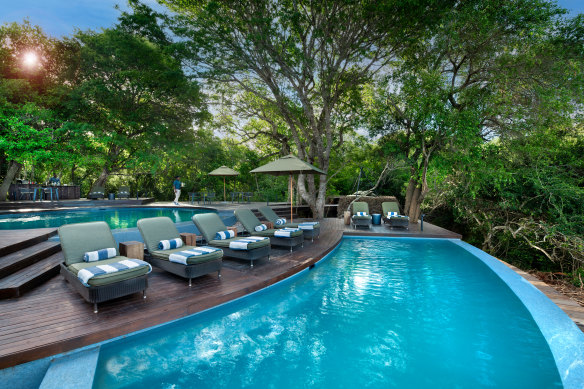
Poolside at Phinda Forest Lodge.
The guides can recount stories about individual animals. When we find two young lions lounging in the grass by a pond, guide James tells their story, how they’d been ejected from their pride by an older, stronger lion and how it’s likely they will return and kill him, or he will separate them and pick them off one by one.
Two young male cheetahs are unperturbed when we sit only a few metres away from them in our car. A female cheetah with her two cubs romps nearby, but out of the sight of the males, who would probably kill her young if they spotted them. Suddenly alert to them, she moves away, calling forlornly for a third cub, which James says was killed a week before.
The key to managing these animals is to maintain a natural balance, says Charli De Vos, Phinda’s ecological manager. While Phinda’s 126 elephants need to be protected from poachers looking for trophies and bush meat, if the reserve has too many elephants, its biodiversity is threatened. The elephants are relocated if populations become too large. “In South Africa we have too many animals, and not enough land,” De Vos says.
It’s important to maintain data on numbers by aerial counts and collars, which use radio frequency to track the herds’ movements. Because herds are matrilineal, collars are placed on the elder females. Contraception, delivered from a helicopter by dart is another tool. Once a herd establishes a home range, the collars are taken off.
The charismatic and shy pangolin is the world’s most trafficked mammal. &Beyond partners with the African Pangolin Working Group on a pioneering conservation project to research and monitor the small anteaters. As with the rhinos, tourists can take part in tagging and tracking the pangolins, contributing to the costs of equipment and research.
The reserve is teeming with leopards, cheetahs, zebras, giraffes, rhinos, hippopotamus, wildebeest, impalas, elephants, baboons, hyenas and buffalo. We even spot a rare caracal lurking in the bushes. But the pangolin remains elusive. I don’t blame it.
Getting a handle on trophy hunters
When Cecil the lion, who was being studied by Oxford university, was killed by a big game trophy hunter in Zimbabwe in 2015 it caused international outrage and drew attention to the practice, which is legal but not considered ethical by some.
Most people are repelled by the concept of trophy hunting, but it’s a complex issue. “We can’t dismiss hunting as a major contributor to conservation,” Dr Snyman says. It’s very well regulated and trophy hunters pay hefty day fees and trophy fees. Ninety per cent of revenue from trophy hunting in Zimbabwe are given back to the community, she says. That can amount to up to $30 million a year.
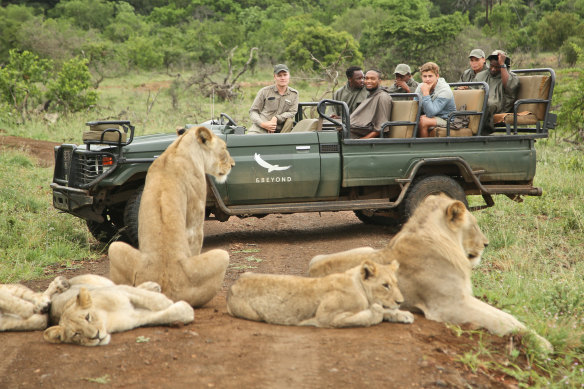
Watching – Phinda Private Game Reserve, South Africa.
Advocates say the sport provides an incentive to protect natural habitats because they become valuable assets. It boosts tourism and controls animal numbers. And it consumes less animals than other forms of hunting, such as bushmeat hunting, which is unregulated and can be indiscriminate.
The trophy hunters leave the animal meat behind and it’s shared by the community. Dr Snyman says there are incidents where trophy hunting has been suddenly banned and local communities not only lost jobs but starved without the protein left by these hunters.
Wildlife ranching, the raising of wild animals for consumption or for hunting, is considered a viable option in South Africa’s more marginal agricultural areas. Today, the country has more wildlife than any other time in the last century and ranching has played an important role in preventing extinction of animals such as wildebeest and zebra. Its formal ranching model is more ethical than the cattle processing practised by most industrial farms in the West, many argue.
If not for hunting revenues, large areas of land would return to farming, which would be much more destructive on ecosystems. Habitat loss is a very real threat. “We all think about looking after the animals, but we have to talk about looking after the land first,” says Kent.
In the shadows
Buccaneer and Spider are not wild animals. They’re two of the dogs trained by Phinda’s Reaction Team to chase down the poachers who regularly make incursions into the reserve.
We meet the security guards and their dogs one afternoon for a demonstration. The guards wear army fatigues and carry high-powered rifles. They look slender and fit, and they have to be – their targets are fast, agile and cunning. “To catch that guy, you have to be Usain Bolt,” says Phinda’s conservation manager, Dale Wepener.
They’re employed from among five local Zulu villages, providing employment. Some were once poachers themselves, which means they know how a poacher thinks. “Poachers operate in the shadows,” says Wepener. “They’re very well researched. We have to be as prepared for them.”
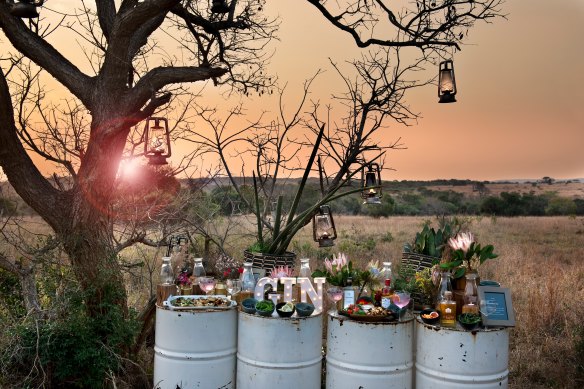
Sundowners.
As scary as the militia look, they are mostly there to gain intelligence and operate passively. They use minimum force. Watching the dogs chase a volunteer “poacher” through long grass, it’s obvious the guards mostly don’t need guns. The dogs are trained to grab the humans in a non-lethal spot. But they don’t let go. And they can follow a scent that’s seven hours old. They’ve managed to track as far as 41 kilometres.
Poachers are not necessarily looking for elephant tusks or rhino horns. Unemployment is a big problem in these communities.
“Just being a poacher doesn’t mean he’s a bad person. He needs to feed his family,” says Wepener. “If someone wants to pay to hunt an animal especially to eat it, I have no qualms as long as it’s done ethically.”
“We don’t claim to have all the answers,” says Joss Kent. But with &Beyond deeply embedded in Africa for 30 years, working in partnership with five local communities and sharing mutual strengths and expertise with the ALU and the Africa Foundation, he’s not about to stop looking.
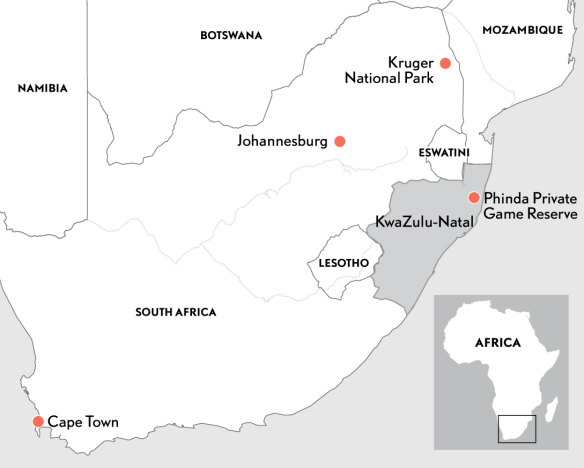
Five other ways to grow the wild economy
Trade in forest products
About 867 million Africans use non-timber forest products like the edible mopane worm for subsistence or cash income. Traditional medicine, widely practised because there are few medical clinics in rural areas, depends on endangered plants such as the pepper bark tree. Giving forest products an economic value creates employment and preserves biodiversity.
The hustle economy
The Africa Foundation collaborates with &Beyond to mentor and invest in young “hustle-preneurs” who operate eco-friendly micro businesses such free-range eggs and organic gardens by helping them to improve their business skills and profitability. See Africa Foundation
Photo tourism
Every visitor to South Africa wants to get memorable shots of the Big Five or the vibrant life in African villages. Responsible photographic tours and safaris can raise awareness and economic support for conservation initiatives by documenting and showcasing the beauty of wildlife and traditional cultures.
Female forward
Many economic activities such as the production of beauty products like shea butter or tourism have low barriers to entry and allow for greater gender equality. The aim is to enable women to profit directly from these industries rather than being lowly-paid in their production.
Carbon markets
In 2022 Africa created an initiative to regulate voluntary trade in carbon. The carbon market can channel investments into forest conservation and restoration and allow new investment to flow into other ecosystems.
THE DETAILS
FLY
Qantas has daily non-stop flights direct from Sydney, and from Melbourne via Perth, to Johannesburg. See qantas.com
STAY
The next five-day/four-night Wild Economy Masterclass at &Beyond Phinda will be held March 2-6 2025. Rates start at ZAR179,015 ($14,020), including return flights from Tambo International Airport to &Beyond Phinda Private Game Reserve, accommodation, meals, drinks, laundry and game viewing activities. There is an emergency medical evacuation insurance and donation contribution of ZAR3000 ($245) a person to the ALU Internship Fund. See andbeyond.com
The writer was a guest of &Beyond
Sign up for the Traveller Deals newsletter
Get exclusive travel deals delivered straight to your inbox. Sign up now.